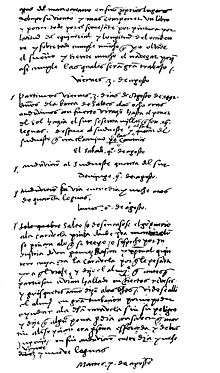Christopher Columbus's journal

Christopher Columbus's journal is a diary and logbook written by Christopher Columbus about his first voyage. The journal covers events from 3 August 1492, when Columbus departed from Palos de la Frontera, to 6 November of the same year. Columbus is known by several contemporary references to have kept a journal of the voyage as a daily record of events and as an evidence for the Catholic Monarchs.[1] Upon his return to Spain in the spring of 1493 Columbus presented the journal to Isabella I of Castile. She had it copied, retained the original, and gave the copy to Columbus before his second voyage.[2] The whereabouts of the original Spanish text has not been known since 1504.[2] Copies based on an abstract from the journal have been made, most notably by Bartolomé de las Casas.[1]
Contents
After a short prologue, the diary begins with Columbus's departure from Spain towards the Canary Islands "half an hour before sunrise" on 3 August 1492. On 16 September Columbus reported he had entered the Sargasso Sea. The journal mentions several animals encountered during the westward voyage, such as dolphins, boobies and frigatebirds. Columbus also describes magnetic declination. While he was not the first to become aware of that, it is assumed that before Columbus's first voyage the Europeans did not know the western magnetic declination, as all areas where the European sailors travelled to had the eastern magnetic declination.[3] The journal also briefly mentions the crew's mood during the voyage. Columbus writes that the covered distance regularly announced to the crew was usually smaller than the real one. On the eve of arrival to the New World the journal reported an unknown light sighting. Even though the journal shows Columbus's imperfect knowledge of the Spanish language, he makes often comparisons of the New World landscape to that of Spain, such as spring like in Andalusia, rivers like those in Seville, hills like those behind Córdoba.[2]
Copies and editions
All existing copies of the journal are based on the journal's abstract – a manuscript of 76 folios discovered later in the library of the Duke of the Infantado by Martín Fernández de Navarrete.[1] The manuscript was kept in the Biblioteca Nacional de España until about 1925, when it was reported as missing.[1] Navarrete reported the discovery of the journal's abstract to his friend, Juan Batista Muñoz who used it in his Historia del Nuevo Mundo published in 1793.[1] In 1825, Navarrete published the abstract with expanded abbreviations, spelled out numerals, proper punctuation and modernized spelling.[1] All editions of Navarrete's copy since 1825 differ to some extent from the Las Casas's copy which has been published in 1962 as a facsimile by Carlos Sanz. In 1892, an edition of Navarrete's copy was published by Italian scholar Cesare De Lollis with critical apparatus.
Bartolomé de las Casas did not have the original journal either and ordered a scribe to make a copy of the journal's abstract discovered by Navarrete.[1] The scribe made several errors while copying the abstract, such as frequent confusions of Columbian leagues with Roman miles.[1] The authenticity of Las Casas's copy was challenged by Henri Vignaud and Rómulo D. Carbia, both of whom believed the copy was largely or entirely a fabrication.[4] In 1939, Las Casas's copy was proven to be authentic by Samuel Eliot Morison and this view was endorsed in later studies.[4]
Columbus's journal was translated into English, Italian, French, German,[1] Russian and other languages. The first English translation was made by Samuel Kettell and published in 1827. In 1991, an English translation based on the Sanz facsimile of the Las Casas's copy was published by the University of Oklahoma Press.
References
- 1 2 3 4 5 6 7 8 9 Samuel Eliot Morison (August 1939). "Texts and Translations of the Journal of Columbus's First Voyage" (PDF). The Hispanic American Historical Review. Retrieved 22 Aug 2015.
- 1 2 3 B.W. Ife. "Introduction to Christopher Columbus, Journal of the first voyage". King's College London. Retrieved 22 Aug 2015.
- ↑ "Комментарии" (in Russian). Vostlit.info. Retrieved 22 Aug 2015.
- 1 2 Margarita Zamora (1993). Reading Columbus. University of California Press. p. 42. ISBN 0520913949.